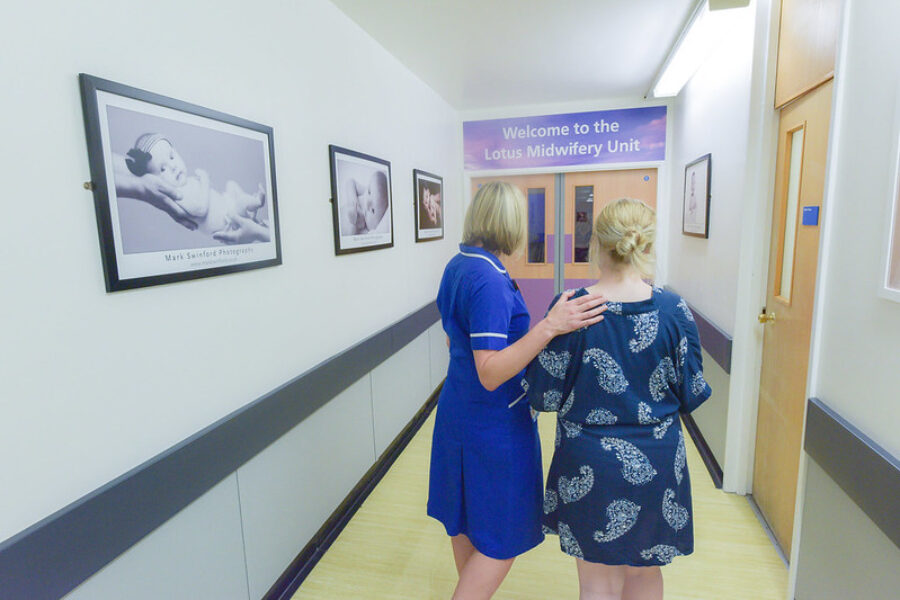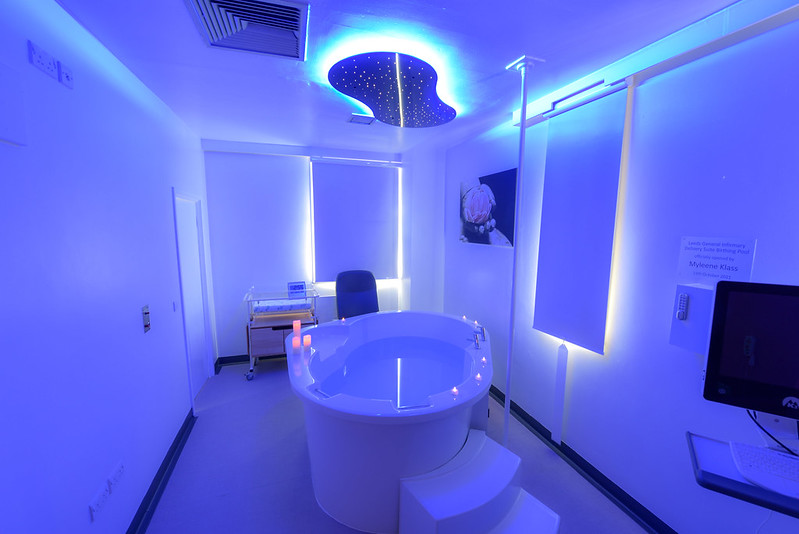
When you think you are in labour please phone the Maternity Assessment Centre . The going into labour page has more information about the early stages of labour. If you are having a planned Caesarean you will be given a date for coming into hospital.
On this page
What to pack in your hospital bag
It’s important to plan ahead and pack your hospital bag a few weeks before your due date. You can find a list of ideas for what to bring here: pack your bag for labour. Claire from Leeds Maternity Voices Partnership has recorded this video with her suggestions too.
What to pack in your hospital bag
Hello my name is Claire and i’m going to be going through with you today the best things to pack for your stay in hospital if you’re planning on delivering in hospital.
When packing it’s important to remember that you’re packing not just for yourself, but for the baby and for your birth partner too. So it’s important to remember that space is limited in hospital so it’s recommended that you bring a small holdall or a small suitcase, and then birth partners and visitors can bring anything extra that you need afterwards.
So for mum we would recommend a nice loose fitting top, a t-shirt nightie that you can wear for delivery that’s easy to pull up for breastfeeding, and then a change of clothes for afterwards too.
Plenty of big comfortable pants for before and after delivery. It’s important to buy pants that are a size bigger than you normally would so that they can pull up over the bump, these are especially better for after a caesarean section.
Plenty of pads as well and you’re going to go through quite a few of those. We recommend the maternity pads as these are bigger, thicker and they don’t have plastic therefore they’re more comfortable for after birth.
A couple of non-underwired bras that are suitable for breastfeeding.
Toiletries, your usual shampoo, conditioner, toothpaste and toothbrush maybe pack two toothbrushes, one for your birth partner too.
We recommend bringing slippers, flip-flops or comfortable shoes so as not to walk around the hospital barefoot.
If you just bring one towel for yourself as we provide the towels for the baby.
We recommend bringing lots of isotonic drinks for energy and also hard boiled sweets. Hard boiled sweets are ideal as you can put those in your mouth and take them out if you have a contraction or if you’re feeling nauseous.
We recommend that you bring snacks for yourself and your birth partner, it’s important that you don’t eat anything too heavy as you may feel quite nauseous during labour.
You may spend quite some time on labour ward so it’s important to think about food, snacks and drinks for your birth partner too.
You need to bring some clothes in for baby, so it’s important that you don’t bring too many clothes as birth partners can bring anything else that you do need afterwards. Three baby grows and three vests is ample to start with. You’ll need a hat for baby and also some newborn size nappies too.
Bring cotton wool or water wipes, it’s not recommended that you use actual baby wipes.
You may spend more time than anticipated on the labour ward so it’s recommended that you bring either a tablet or some reading materials, crosswords or word searches just because it can get boring.
Make sure that your birth partner has enough petrol in the car and that you have change available for parking when you arrive at the hospital.
Birth partners
You can have up to two people with you while you are giving birth. They can stay with you in hospital while you are on the delivery suite including overnight. You can choose if you’d like your birth partner to cut your baby’s umbilical cord.
Where can I give birth?
Your community midwife will explain the different places that you can give birth in hospital. Please watch the video below for a virtual tour of our facilities.
Delivery suites
There are single rooms on the delivery suite and some have en-suite bathrooms. The rooms can be adapted to support your choices for birth. You will be looked after by our midwives and there are specialist doctors available if needed.
Lotus Unit
The Lotus Midwifery Led Unit is at Leeds General Infirmary. There are three rooms (including two pool rooms). The focus of the unit is to create a “home from home” so that you can have an active birth in a calm environment.
The rooms are beautifully decorated with birth affirmations, music systems and aromatherapy diffusers. The unit also includes a small multi purpose ‘snug’ in which you can make refreshments, mobilise or await the final checks before going home.
Can I have a water birth?
There are water birth pools at both hospitals. Please talk to your midwife if you’d like to have a water birth.

What pain relief can I have?
Your midwife will talk to you about the different pain relief options and any side effects they might have. Pain relief includes paracetamol, gas and air, diamorphine and epidural. The video below includes information about pain relief and having a water birth.
Pain relief during labour and information about having a water birth
Your midwife will advise what form of monitoring is best suited for you.
Every labour for every woman is completely different, and every woman has different coping mechanisms and different pain thresholds. So what works for one woman would not necessarily be the right choice for another woman.
The aim of pain relief is relaxation, believing in yourself cannot be underestimated. If you believe you can do this then you will do this.
We have varying forms of pain relief that are on offer. Having a warm bath and taking regular paracetamol is always good to aid relaxation. It is important to inform staff of any paracetamol and what doses you have taken at home.
TENS machines can be sourced externally if you wish to try them. TENS works by transmitting a gentle electrical stimulation through the skin. You tend to feel this as little pins and needles in your back. This works by stimulating the body’s natural painkillers endorphins.
Stronger forms of pain relief may be available for a home birth and it is important that you discuss this with your midwife.
Contractions are one of the weirdest pains you will ever experience, as they are very intense when they come but then they wear off and you get a break in between them and at the end you’ve got a beautiful baby.
Entonox is widely available for labour. Entonox or gas and air as it is also known is breathed in using a mouthpiece. Gas and air can take about 20 seconds to take effect and it is important you breathe it deeply as soon as you start feeling your contraction through the duration of your contraction, and then you’re at the maximum effect of the gas and air at the peak of that contraction. Gas and air comes out of your system very quickly once you start taking breaths of fresh air. Gas and air really helps you focus on your breathing which it can be very difficult sometimes when you’re in a lot of pain.
Injectable pain relief or opioids are known as diamorphine, morphine. These drugs are injected into a muscle either in your thigh or your bottom. Sometimes opioids can make you feel a little nauseous and sick so we tend to give them with an anti-sickness injection. Opioids are very strong painkillers that make you feel very relaxed. They will not take the pain away but you are far more relaxed throughout your labour. If you have an opioid injection, gas and air can also be used if needed for the contractions. Because the injections make you feel sleepy and relaxed they can also have that effect on baby. This is why we don’t like to give it too close to delivery as it can sometimes delay babies interest in feeding and make them a little bit slow to breathe to start.
Another form of pain relief is an epidural or regional anaesthesia. The effects of an epidural are very individual some people experience very numb and heavy legs and some people can have full movement of their legs. However we would not recommend getting out of bed if you have an epidural sighted. If you are wanting an epidural it is important to note that you will need to receive a brief period of continuous monitoring.
During active labour it is really important that your bladder remains empty this can be very difficult when you’re in labour as because of the position of baby’s head you don’t necessarily feel that you need to empty your bladder. If you are unable to empty your bladder your midwife would recommend the insertion of a catheter to empty your bladder and then remove the catheter. This is to avoid any permanent damage to your bladder. An epidural can last the whole duration of your labour and one’s baby and placenta have been delivered we would turn off the infusion pump and remove the catheter from your back. It can take up to a couple of hours for full sensation of your legs to return.
Water births can provide excellent forms of natural pain relief. Pools can be hired privately if you are wanting a home water birth. We have two water pools available at St James’s and three birthing pools available at LGI, therefore the likelihood of one being available is high.
Water births are really really relaxing and create a beautiful environment. The lights in the rooms are quite dim, we have battery operated tea lights or you are more than welcome to bring your own tea lights in if they are battery operated to use.
Entonox or gas and air can be used whilst you were in the pool. Whilst you’re in the pool the midwife still needs to monitor your contractions and baby’s heartbeat. If a vaginal examination is needed it can be performed in the pool but sometimes this may be difficult and you may need to get into an uncomfortable position, and for this reason it may be recommended for you to get out of the pool for an examination to occur.
It’s personal preference what you wear in the pool you can choose to be naked or wear a bikini top or a vest top, it is your choice.
At the time of delivery you can choose to get out of the pool to deliver your baby or you can remain in the pool to deliver your baby and your placenta. If you choose to deliver baby and placenta within the pool we would recommend a physiological third stage of labour where no injection of hormones are given.
Sometimes following a water birth the huge cry that we associate with a baby being born sometimes is delayed. This is because baby is not stimulated by the cold air once it is born, it is born into water that is of body temperature and that stimulation to breathe can sometimes be delayed.
A water birth can increase the risk of you sustaining a deep perineal tear that may involve your back passage. It is therefore recommended that you commence perennial massage at around 34 weeks pregnancy to help reduce this risk.
Patient information
Related pages
Share feedback about your experience
We encourage you to tell us about your maternity care and whether you would recommend us to your friends and family.
Share maternity feedback